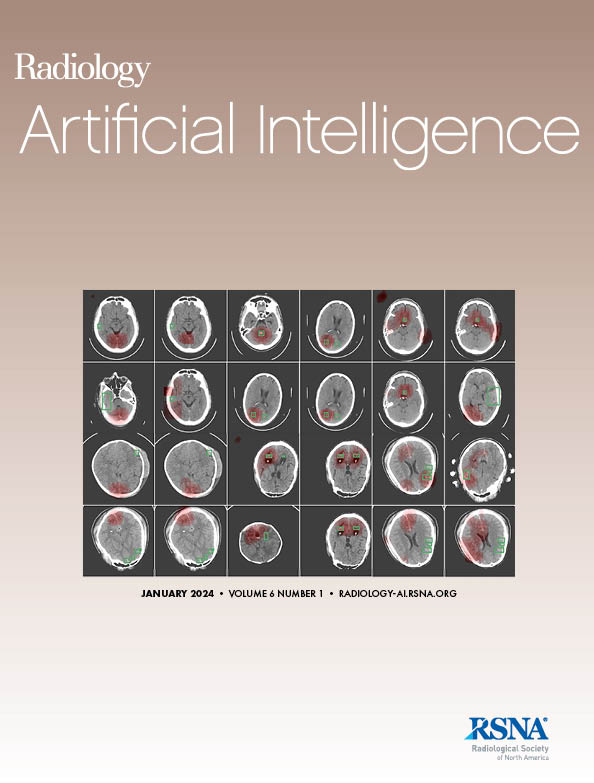Zhongyi Zhang, Julie A Hides, Enrico De Martino, Janet R Millner, Gervase Tuxworth
求助PDF
{"title":"多序列MRI对腰椎棘旁肌肉自动分割和组成分析的多中心验证。","authors":"Zhongyi Zhang, Julie A Hides, Enrico De Martino, Janet R Millner, Gervase Tuxworth","doi":"10.1148/ryai.240833","DOIUrl":null,"url":null,"abstract":"<p><p>Chronic low back pain is a global health issue with considerable socioeconomic burdens and is associated with changes in lumbar paraspinal muscles (LPMs). In this retrospective study, a deep learning method was trained and externally validated for automated LPM segmentation, muscle volume quantification, and fatty infiltration assessment across multisequence MR images. A total of 1302 MR images from 641 participants across five centers were included. Data from two centers were used for model training and tuning, while data from the remaining three centers were used for external testing. Model segmentation performance was evaluated against manual segmentation using the Dice similarity coefficient (DSC), and measurement accuracy was assessed using two one-sided tests and intraclass correlation coefficients (ICCs). The model achieved global DSC values of 0.98 on the internal test set and 0.93 to 0.97 on external test sets. Statistical equivalence between automated and manual measurements of muscle volume and fat ratio was confirmed in most regions (<i>P</i> < .05). Agreement between automated and manual measurements was high (ICCs > 0.92). In conclusion, the proposed automated method accurately segmented LPM and demonstrated statistical equivalence to manual measurements of muscle volume and fatty infiltration ratio across multisequence, multicenter MR images. <b>Keywords:</b> MR-Imaging, Muscular, Volume Analysis, Segmentation, Vision, Application Domain, Quantification, Supervised Learning Type of Machine Learning, Convolutional Neural Network (CNN), Deep Learning Algorithms, Machine Learning Algorithms <i>Supplemental material is available for this article.</i> © RSNA, 2025.</p>","PeriodicalId":29787,"journal":{"name":"Radiology-Artificial Intelligence","volume":" ","pages":"e240833"},"PeriodicalIF":13.2000,"publicationDate":"2025-09-01","publicationTypes":"Journal Article","fieldsOfStudy":null,"isOpenAccess":false,"openAccessPdf":"","citationCount":"0","resultStr":"{\"title\":\"Multicenter Validation of Automated Segmentation and Composition Analysis of Lumbar Paraspinal Muscles Using Multisequence MRI.\",\"authors\":\"Zhongyi Zhang, Julie A Hides, Enrico De Martino, Janet R Millner, Gervase Tuxworth\",\"doi\":\"10.1148/ryai.240833\",\"DOIUrl\":null,\"url\":null,\"abstract\":\"<p><p>Chronic low back pain is a global health issue with considerable socioeconomic burdens and is associated with changes in lumbar paraspinal muscles (LPMs). In this retrospective study, a deep learning method was trained and externally validated for automated LPM segmentation, muscle volume quantification, and fatty infiltration assessment across multisequence MR images. A total of 1302 MR images from 641 participants across five centers were included. Data from two centers were used for model training and tuning, while data from the remaining three centers were used for external testing. Model segmentation performance was evaluated against manual segmentation using the Dice similarity coefficient (DSC), and measurement accuracy was assessed using two one-sided tests and intraclass correlation coefficients (ICCs). The model achieved global DSC values of 0.98 on the internal test set and 0.93 to 0.97 on external test sets. Statistical equivalence between automated and manual measurements of muscle volume and fat ratio was confirmed in most regions (<i>P</i> < .05). Agreement between automated and manual measurements was high (ICCs > 0.92). In conclusion, the proposed automated method accurately segmented LPM and demonstrated statistical equivalence to manual measurements of muscle volume and fatty infiltration ratio across multisequence, multicenter MR images. <b>Keywords:</b> MR-Imaging, Muscular, Volume Analysis, Segmentation, Vision, Application Domain, Quantification, Supervised Learning Type of Machine Learning, Convolutional Neural Network (CNN), Deep Learning Algorithms, Machine Learning Algorithms <i>Supplemental material is available for this article.</i> © RSNA, 2025.</p>\",\"PeriodicalId\":29787,\"journal\":{\"name\":\"Radiology-Artificial Intelligence\",\"volume\":\" \",\"pages\":\"e240833\"},\"PeriodicalIF\":13.2000,\"publicationDate\":\"2025-09-01\",\"publicationTypes\":\"Journal Article\",\"fieldsOfStudy\":null,\"isOpenAccess\":false,\"openAccessPdf\":\"\",\"citationCount\":\"0\",\"resultStr\":null,\"platform\":\"Semanticscholar\",\"paperid\":null,\"PeriodicalName\":\"Radiology-Artificial Intelligence\",\"FirstCategoryId\":\"1085\",\"ListUrlMain\":\"https://doi.org/10.1148/ryai.240833\",\"RegionNum\":0,\"RegionCategory\":null,\"ArticlePicture\":[],\"TitleCN\":null,\"AbstractTextCN\":null,\"PMCID\":null,\"EPubDate\":\"\",\"PubModel\":\"\",\"JCR\":\"Q1\",\"JCRName\":\"COMPUTER SCIENCE, ARTIFICIAL INTELLIGENCE\",\"Score\":null,\"Total\":0}","platform":"Semanticscholar","paperid":null,"PeriodicalName":"Radiology-Artificial Intelligence","FirstCategoryId":"1085","ListUrlMain":"https://doi.org/10.1148/ryai.240833","RegionNum":0,"RegionCategory":null,"ArticlePicture":[],"TitleCN":null,"AbstractTextCN":null,"PMCID":null,"EPubDate":"","PubModel":"","JCR":"Q1","JCRName":"COMPUTER SCIENCE, ARTIFICIAL INTELLIGENCE","Score":null,"Total":0}
引用次数: 0
引用
批量引用

 求助内容:
求助内容: 应助结果提醒方式:
应助结果提醒方式:


